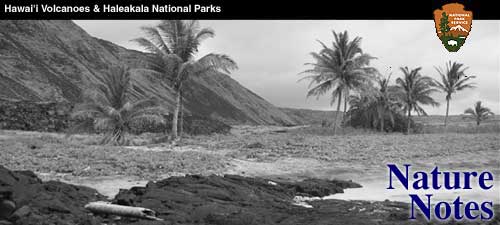

|
|
HAWAII NATURE NOTES
PULU The young fronds of certain ferns, especially tree ferns, are covered with a bronze-colored silky floss called "pulu." Used by the ancient Hawaiians as an absorbent, for surgical dressings, and even in embalming their dead, pulu became an item of export importance to the mainland from the 1860's to 1884. During this period some 4,271,119 pounds were shipped, according to Degener (2). It was used primarily for stuffing mattresses, pillows, and upholstery. Carl P. Russell in his One-Hundred Years in Yosemite (1947, p. 102) quotes Caroline M. Churchill, a visitor to Leidig's, a Yosemite hostelry established in 1869: "At this place the beds are cleanly and wholesome, although consisting of pulu mattresses placed upon slat bedsteads." The remains of the old pulu factory may be seen today in Kilauea section about 1.8 miles below Makaopuhi Crater on the trail to Napau Crater. Here the pulu was dried and baled before being taken seaward over the pali to Keauhou Landing for loading onto mainland-bound vessels. Although a high percentage of pulu was gathered from Kilauea ferns, the industry fortunately terminated about 1885, and no more ferns were cut for the small amount of pulu obtained from each. The hike to the pulu factory is not strenuous, and is one of the most interesting in Hawaii National Park.
|
| <<< Previous | > Cover < | Next >>> |
nature_notes/havo/vol5-1c.htm
24-Mar-2006